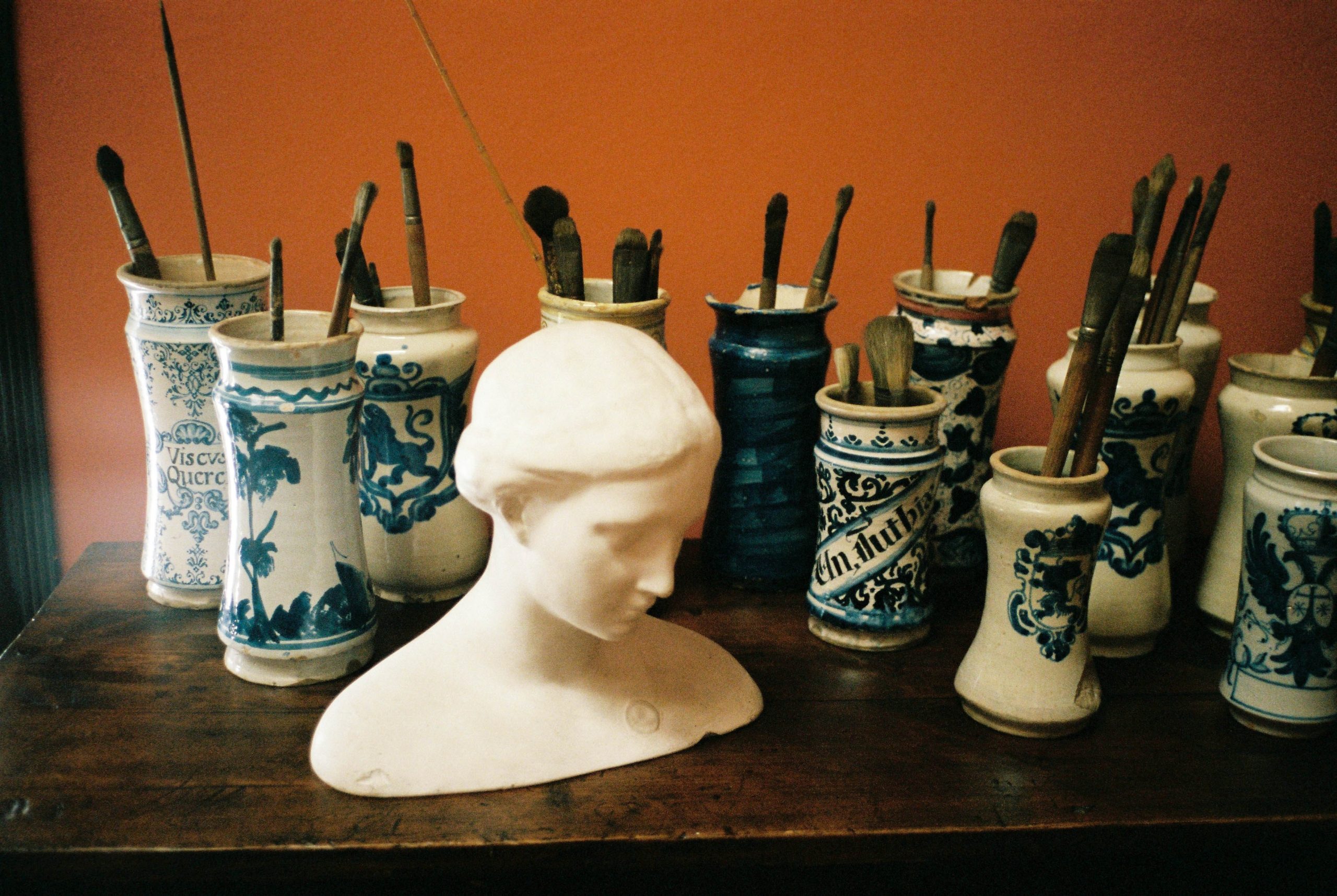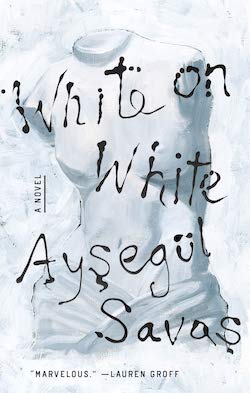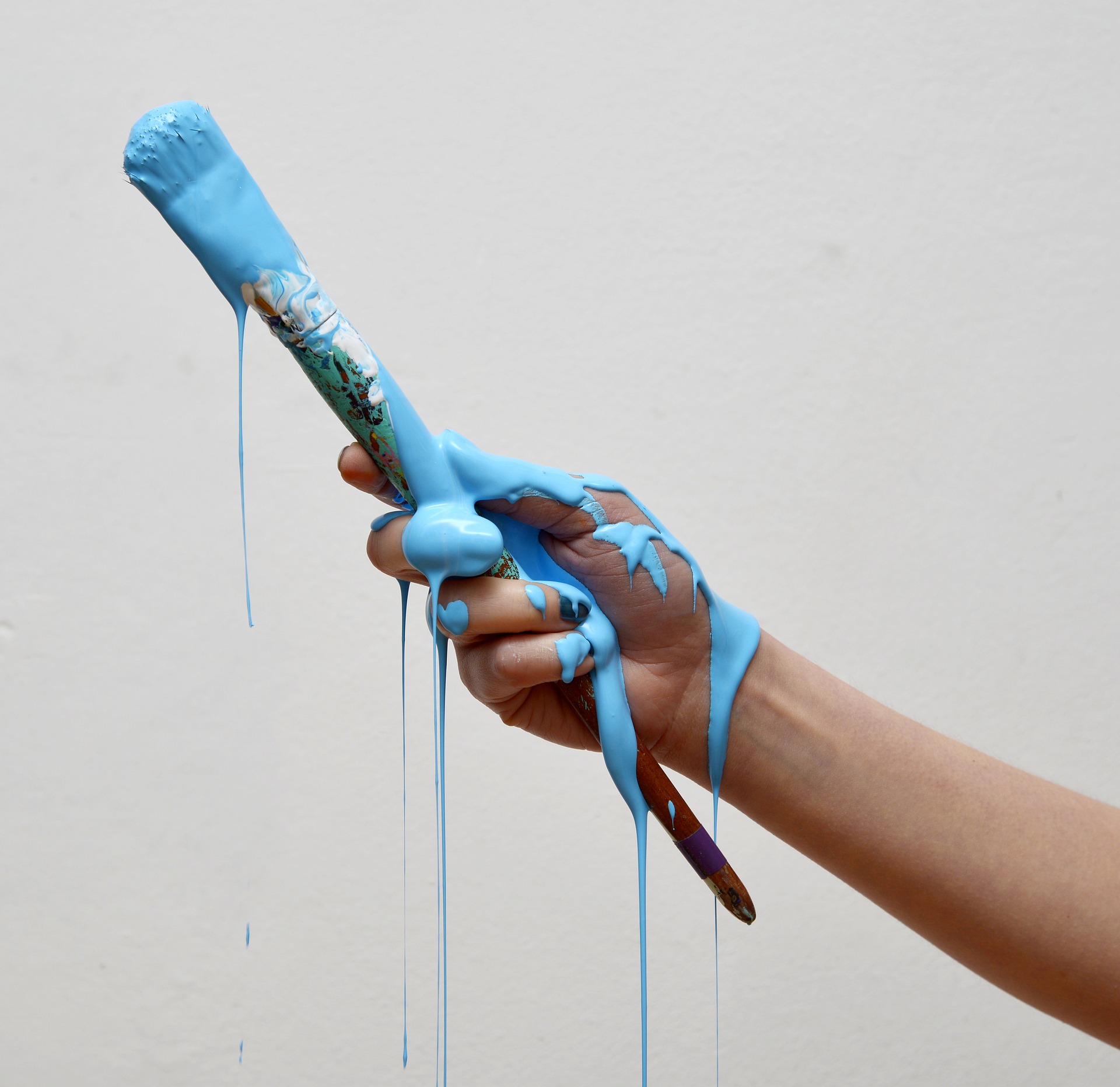Lit Mags
No One Likes a Copycat Au Pair
"Ways of Seeing" an excerpt from WHITE ON WHITE by Ayşegül Savaş, recommended by Sanaë Lemoine

Introduction by Sanaë Lemoine
I loved Ayşegül Savaş’s first novel Walking on the Ceiling and have been pressing it into everyone’s hands for the past two years. I approached her second novel, White on White, with excitement and some trepidation, wondering whether I would love it as much. Well, the answer is yes. How exhilarating to be swept off my feet once more, torn between wanting to savor every sentence while also wishing to rush through to the end! Savaş’s writing is unadorned and yet perfectly attuned to the poetry and strangeness of everyday life. It surprises you with kernels of wisdom, such as “We make ghostly twins to carry the weight of our desires.” The world she describes is both recognizable and slightly off-balance, and nothing is ever what it seems at first glance. It is writing that I devoured in a few sittings and then returned to over and over again.
 The premise of White on White is simple—a young student moves to a new city and becomes a confidant of sorts to the landlady, Agnes, a striking and magnetic artist, who very soon unsettles the narrator with her intimate monologues. Much of the novel is shaped by scenes in which the student listens to Agnes reflect on her art and recount memories of her marriage, children, and friendships with other women. At times I was reminded of Territory of Light by Yuko Tsushima. Both narrators spend a year in a new apartment that is flooded with light. The passage of time feels hazy and is often marked by the change in seasons. There is an undercurrent of tension, barely perceptible at first, that intensifies throughout and makes it impossible to look away.
The premise of White on White is simple—a young student moves to a new city and becomes a confidant of sorts to the landlady, Agnes, a striking and magnetic artist, who very soon unsettles the narrator with her intimate monologues. Much of the novel is shaped by scenes in which the student listens to Agnes reflect on her art and recount memories of her marriage, children, and friendships with other women. At times I was reminded of Territory of Light by Yuko Tsushima. Both narrators spend a year in a new apartment that is flooded with light. The passage of time feels hazy and is often marked by the change in seasons. There is an undercurrent of tension, barely perceptible at first, that intensifies throughout and makes it impossible to look away.
The excerpt below recounts Agnes’s years as a new mother and her relationship with her young au pair, beautifully exemplifying what I loved most about Savaş’s novel: the stories within stories, showing how what we remember from our past illuminates the way we see ourselves; the dissonance of memories within a family and how those breaks in understanding reveal an unwillingness or inability to see. At the end of this passage, the student feels that Agnes has “left out a part of the story.” One of the pleasures of reading White on White comes from exploring those omissions and being never quite sure what to believe. I reveled in this ambiguity: the constant shifts in perception, my expectations overthrown with each story.
My favorite books provide a richly imagined world while leaving the reader enough space for their imagination to roam. Early in the novel, the student says, “There was no clear course of study for entering another’s consciousness, historical or not. This was as difficult a task as undoing one’s own mind, unraveling each layer of thought with all its prejudices and assumptions.” As I turned the last page, I felt entirely immersed in the consciousness of the novel, bound to the characters, my future just as uncertain as theirs. I hope you will feel the same. And now I cannot wait to press both of Ayşegül Savaş’s novels into everyone’s hands.
– Sanaë Lemoine
Author of The Margot Affair
No One Likes a Copycat Au Pair
Ayşegül Savaş
Share article
“Ways of Seeing” by Ayşegül Savaş
Agnes, my landlady, was standing in front of the building, wrapped in a dark blue shawl that swallowed her thin shoulders, twisting and folding luxuriously around her torso.
It had been a long day at the archives: I’d gone through the illustrations of several books of hours from the northern region. The majority of historiated initials represented women in supplication. I had only gotten up from my table as the archives announced its closing.
Agnes appeared to be looking for something in her bag and I thought she must have lost her keys, but I noticed when I came closer that she was holding them in one hand.
“Back from the archives?” she asked. It was true that I didn’t have much variation to my days but I was nevertheless taken aback. Had she been waiting for me at the door, guessing the hour of my return?
Beneath the blue shawl, she was wearing a wool purple coat. A red scarf was knotted at her neck. Even though the colors were striking, they were also unharmonious, as if she had chosen her outfit in the dark. In fact, her appearance suddenly struck me as disturbed.
She suggested going to the café next door. Hadn’t she been on her way somewhere, I asked.
“Not really,” Agnes said. “I thought I’d just step out for a little and then I ran into you.”
Again, I wondered with some irritation whether she had been waiting for me to come back. Still, I had to maintain a good relationship. Agnes’s husband Pascal was an important scholar in my field—it was through the art history department that I’d found my lodging—and he would most likely be on my dissertation committee the following semester. I had never met Pascal in person; Agnes had come to the city alone, with the intention to paint in the studio above my flat.
“Just a quick coffee,” Agnes said. “But feel free to tell me if you’d rather not.”
Alright, I told her, adding that I’d need to get going soon.
“Did you have plans?” She may have been calling me out, or she may have asked in all sincerity.
Yes indeed, I said. In reality, all I wanted was to be back in my room.
At the café, we took the back table. Agnes ordered a black coffee and asked for milk on the side, though she didn’t pour any into her cup once it arrived. She asked me if I’d had a good day. I was too tired to tell her about my findings at the library. I said that I’d gotten a lot of work done.
“You’re so productive,” she said. “I envy your discipline.”
She, on the other hand, had been distracted all day, fiddling with a painting she’d recently started. In the afternoon, after a phone conversation with her daughter, she’d finally decided to put the painting aside. She would get to work seriously tomorrow, or the day after.
It had happened once or twice before, she told me, that she’d felt so detached from her work and could find no way of relating to it. At those times, too, it had taken a while to make her way back to the surface and see things afresh.
After the birth of her children, when every day passed in a flurry of activity, the small and repeated tasks consuming days and months, she’d come to view her paintings as belonging to another person; someone who probed the world with curious superficiality. In the time that passed, with nothing more than ideas for works and a handful of sketches, she’d begun to doubt that she had anything of worth to communicate.
She’d felt so detached from her work and could find no way of relating to it. At those times, too, it had taken a while to make her way back to the surface and see things afresh.
What did it matter, she wondered, the fruit placed on the table, showing off its angles and colors in a perfect assembly, the landscapes, the interiors, the bodies, and all the forms close to abstraction that provided momentary relief from the world? Her paintings appeared rigid to her, even meaningless, though they had done well in her absence. Her gallery encouraged her to continue on the work she’d been doing before her children were born, as did her husband Pascal. His own research had continued steadily through the children’s births, without the slightest obstacle to his routine. It was Pascal’s idea to hire an au pair—a distant relative of someone at his department—who would live with them for two years and take over the children’s care during the day. Agnes consented, even though what she’d wanted from him was to take a step back and reevaluate their lives, rather than rushing to make things as they had been before.
When speaking of the toll of motherhood, women pointed to the time that was taken from them and never quite given back. But what was lost was also the capacity for selfishness and single-mindedness. Agnes wanted Pascal to share in this loss, for the two of them to let go of their work and to pick it back up in time, after they’d come to terms with the shock of what had happened to them.
The top of Agnes’s head was illuminated by the golden evening light. I noticed that the thin strands of hair, pulled back as usual into a low ponytail, barely covered her scalp.
She brought her coffee cup to her chest, held it there for several seconds.
The au pair, Jana, arrived on a rainy weekend. Standing in the hallway beside her suitcase, she looked as if she would burst into tears. Pascal’s colleague had told them that Jana was more mature than her years; she’d recently graduated from university and was taking some time to decide what to do next. But it seemed to Agnes that the stranger at the door was really just a child. She asked to go up to her room at once. After an hour, she emerged having changed into baggy, colorless clothes, looking as if she’d prepared herself for arduous physical labor. She barely spoke that whole day, though she listened carefully to the instructions given her: what time the children had breakfast, what time they needed to be picked up from nursery school, what they ate for snacks.
Those first weeks, she didn’t join conversations during dinner even though she sat with them the entire time. Agnes supposed the girl must be homesick or very shy; other times, that she despised them.
It was also unclear whether Jana liked the children. Of course, Agnes added, it was naïve to expect real affection from a stranger hired to work for them.
One Sunday morning, Agnes’s son appeared in the kitchen and asked whether Agnes knew that an angel resided on his right shoulder and a demon on his left. If only he focused hard enough, the child continued, he could hear what they were saying. He closed his eyes and stretched his arms in front of him, as if he were walking in his sleep. “It will be a stormy day,” he finally proclaimed. “And then sunny.”
Pascal was reluctant to confront the au pair, insisting that their son had probably made up the whole thing. Anyway, Pascal said, there was no need to cause trouble just as Jana was finally warming up to the family. So, it was Agnes who had to speak to her, when Jana came home after her day off.
They all wondered what she did on those days, slipping out before breakfast and not appearing until dinner was off the table. Agnes didn’t think the girl had any friends. The shops in town were closed. She imagined Jana sitting alone on a bench, wandering aimlessly around town, just so she could be by herself.
The anecdote about the angel and demon, Jana said, was something she’d heard when she was a child herself. The children weren’t even scared, she insisted. But as Agnes explained to her how such a story would no doubt be startling, would deform out of proportion into a nighttime army of chimeras, Jana began to nod. Alright, she said bitterly, she’d never tell such stories again. In fact, she would never tell the children any stories but only read from the books that Agnes selected.
“That’s not what I meant,” Agnes said, though she was aware that the argument had already shifted off track.
From time to time, Agnes went into Jana’s room with renewed determination to act motherly, to soothe out whatever troubles the girl harbored. She told Jana that she wanted to know more about her and tried to recount amusing anecdotes from her own day. The girl sat silently at the edge of her bed, cheeks flushed crimson, as if she were being unjustly scolded. She answered all of Agnes’s questions without offering anything more, as though determined not to reveal any part of herself—out of fear, or stubbornness, it was hard to tell. It was on one of these evenings that she asked Jana, having gotten nowhere in conversation, whether she could paint her portrait.
“She was extraordinarily beautiful,” Agnes said to me. “Did I already say that?” She swirled the pitcher of milk on the table then finally poured a few drops into her empty coffee cup.
For some reason, they all took pride in the girl’s beauty, as if Jana had chosen them as friends; as if her good looks meant something about them as well. To Agnes’s surprise, Jana agreed immediately to having her portrait painted. The following day, she sat in front of the easel, hands stacked on her lap. She posed as still as a rock, like she were a trained painter’s model, her eyes fiercely introverted.
Agnes worked slowly, over several weeks, building outwards from Jana’s eyebrows, which formed a slight crease above her nose, her wide, tinted cheeks, her pursed, proud mouth. The face, as it emerged, did not so much reflect her beauty as it did her reserve, the frown of suspicion as Jana studied her painter.
“She gave me the chills,” Agnes said. She added, also, that the girl thrilled her.
In the two years she lived with them, Jana always had a project to which she dedicated herself with discipline: memorizing monologues from plays, looking through art books, reading dated classics she couldn’t possibly have been interested in. If the children wandered into her room during her free time and asked to participate, she would firmly ask them to leave. It was admirable, Agnes and Pascal remarked, how seriously she took on the task of educating herself. Pascal lent her books and sometimes sat with her in the evenings quizzing her, delighted by the girl’s dedication to whatever he gave her. Jana was more at ease around him, even joyful.
Agnes had noticed, when she went into the girl’s room to bring her flowers or fresh linen, that Jana painted watercolors in a small rectangular notebook, the pages crammed full of sketches. There were the objects of her room, the neighborhood streets, drawings of children that resembled Agnes’s son and daughter.
Agnes looked up from her cup and studied my face as if she were looking into a mirror. “Perhaps she was the reason I went back to painting seriously,” she said.
Not necessarily because of the time Jana afforded her, but out of rivalry with the young stranger in her household, who spent almost as much time painting as Agnes did. Eventually, Jana began working on larger sheets and later on canvases, all of which she propped up around her bedroom, perhaps for Agnes to see. She was annoyed with the girl for painting so much, considered it dishonest, maybe because Jana had gotten the idea from her, or because she’d never asked Agnes for help.
“You’d think,” Agnes said, “that she was in competition with me.”
Still, she continued, it was a happy time, those two years of living with an au pair. This was when they settled into the rhythms of being a family, with an order to the way they lived their lives. In the presence of an outsider, their dinners were livelier, their affections softer. They teased each other and made up endearments, hoping to enchant Jana and catch her attention. Agnes remembered that at that time she even set the table with greater care, thinking to light candles, put out cloth napkins. She might prepare casual desserts, though this was not standard in their family, or cook something involving ritual and various steps—a pitcher of sauce on the side of soup, shells to crack, a recipe from fleeting seasonal vegetables—as if they had always enacted these traditions. Pascal was engaged, the way he was around students, and more charismatic than Agnes had ever known him to be at home. And whatever Jana might have felt about them, it was always clear that she watched them greedily.
In the presence of an outsider, their dinners were livelier, their affections softer. They teased each other and made up endearments, hoping to enchant Jana and catch her attention.
Something else, Agnes now remembered, was that Jana began to dress like her. It didn’t happen all at once, nor was it unexpected. Agnes had given the girl many clothes—ones that no longer fit her, others that she considered too youthful. The first time, she asked Jana to look through some bags and take whatever she wanted from them before she brought the rest to the charity in town. The girl took everything. Agnes was flattered, and assembled more things. Jewelry, scarves, bags. There were items she gave Jana even though she still wore them. Agnes felt satisfaction in her own generosity and the acknowledgment of her good taste each time
Jana accepted her things. But her generosity, she added, was no different from her pride. It was not out of kindness that she gave Jana those things, but a pretense of it.
The girl wore Agnes’s clothes in surprising configurations, with pieces that had never belonged together. She made them eccentric yet alluring, as if she were playing the role of Agnes in a film.
It was during this time that Agnes began her series of portraits, starting with Jana, then her husband and children and other acquaintances who sat for her. She no longer had any interest in professional models; she only cared to discover the people she knew through her paintings. But the cold and expository style of these works, whose faces were made up of a network of bulging veins, had worked most startlingly for the portraits of the au pair.
Their friends often observed how much Jana had changed while living with them, from a shy, unremarkable child to an assured young woman. She should be grateful to Agnes and Pascal, they said. By this time, Pascal had convinced Jana to apply to the art history department and had more or less arranged for her admission. It happened abruptly that their life together came to an end and Jana moved to a campus dormitory to start school. Within days of her departure, Pascal found someone to take her place as a nanny. The children were upset for a day or two, but quickly adjusted to the older woman who came several days a week, bringing them home from school and preparing their snacks before leaving in the early evening, when Agnes would be done with her work in the studio. Jana didn’t come over for dinner, or for weekend outings.
Agnes had learned that the essence of a relationship often became apparent with separation. In Jana’s case, it was evident that the girl had been neither family nor a real friend.
Once or twice, Agnes had seen her on campus. She had grown at once fuller and finer, though she looked no more confident than that first Sunday afternoon when she’d stood, forlorn, on their doorstep.
One time, Agnes had cycled past Pascal and Jana, eating lunch at a park adjacent to the campus. They were glowing, Agnes thought, immersed in what appeared to be an animated conversation. Or perhaps it was simply the ease they had in each other’s company. For a moment, it seemed that Agnes was watching two strangers. She hadn’t known that the two of them kept in touch, though she probably could have guessed it. She didn’t stop to say hello.
Agnes looked down into her cup, with its shallow pool of milk.
She was remembering all this, she said to me, because of a conversation she’d had with her daughter. On the phone this morning, her daughter mentioned that the topic of the au pair had come up in therapy. Agnes was skeptical of the things that emerged at her daughter’s therapy sessions, which often suited her daughter’s immediate needs and urges particularly well, but she was nonetheless startled by this particular memory.
How was it, her daughter asked, that this young girl had lived with them for so long even though Agnes deplored the girl’s presence? And why had Agnes never said a word about it, choosing, instead, to be willfully blind?
I asked Agnes what her daughter had meant by that.
“You see,” Agnes said, “I was just as puzzled. She was on the verge of tears on the phone, but I didn’t really know what exactly she was referring to.” She kept her eyes lowered on the cup. “There was nothing she could have witnessed,” she added. “I’m quite sure of that.”
Her daughter, now crying, went on to say that what she remembered most of all was the terrible constraint of that time; the fear that her mother might suddenly be angry, even though she appeared so calm. The fear that their lives might shatter. It was only now, her daughter said, that she could look back on those years and wonder why Agnes had chosen to react as she did—silent and resentful—knowing that this would only hurt her own children.
“She couldn’t bring herself to speak very clearly,” Agnes told me, “and I didn’t want to push her.”
Before hanging up, her daughter asked whether Agnes remembered the way she used to calmly fold her napkin in the middle of dinner, then suddenly excuse herself. What did she want to say to them in those moments, as she and her brother waited in trepidation for a disaster that never arrived? And she wondered now, with the therapist’s probing, about the au pair’s disappearance from their lives, the smooth arrangement of her removal without a scene.
“But it wasn’t a disappearance at all,” Agnes insisted, like she were trying to convince me as well. “The girl had figured out what she wanted to do with her life and she got some help from Pascal to achieve it.
“Surely you know how these things go,” she said, “when professors pull a few strings.”
It sounded, I began, as if Agnes had left out a part of the story. My voice was cool, measured. I wanted to go on, to get at the heart of something—what was it exactly? Curiosity, irritation, a wish for accountability or an urge to be cruel.
As if to prevent me from speaking, Agnes raised her hand.
“I know you have plans for the evening,” she said. Then all at once, she summoned the waiter.








